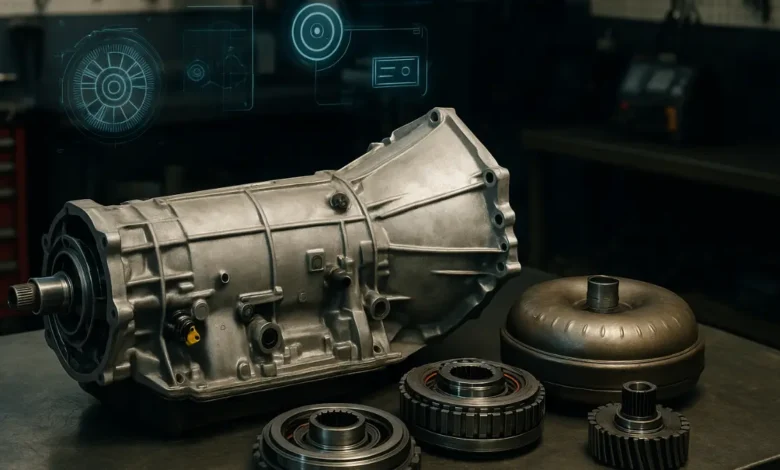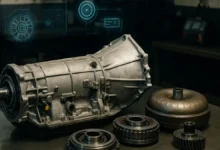4L60E Transmission: A Complete Expert Guide

Learn everything about the 4L60E transmission: history, specs, common problems, upgrades, maintenance, and expert insights. A complete guide for GM owners and enthusiasts.
The 4L60E transmission is one of the most well-known automatic transmissions used in a wide range of General Motors vehicles. Whether found in Chevy trucks, SUVs, or performance cars, this unit has gained a reputation for reliability, adaptability, and ease of maintenance. For decades, mechanics, enthusiasts, and drivers have worked with the 4L60E, and understanding it fully can save time, money, and frustration.
This article breaks down everything you need to know in a clear, casual, yet expert way. From its history and design to common issues, upgrades, and maintenance, the following guide provides a deep dive into the 4L60E transmission world.
History and Development of the 4L60E Transmission
The 4L60E transmission has its roots in the earlier 700R4, which was introduced in the early 1980s. As the automotive world transitioned into electronically controlled systems, GM replaced hydraulic controls with computer-driven solenoids and sensors, giving birth to the 4L60E.
This transition was not only about keeping up with new automotive technologies but also about improving efficiency and reliability. The “E” in its name represents electronic control, which allowed for smoother shifting, better adaptability to driving conditions, and improved fuel economy. Over time, this model became a staple in GM’s lineup, being installed in everything from family sedans to heavy-duty trucks.
As emissions regulations tightened and fuel economy standards grew more important, the 4L60E’s electronic control became a key selling point. The system allowed vehicles to optimize shift points depending on load, throttle input, and speed. This made it versatile enough to serve different vehicle classes, from light-duty SUVs to high-performance cars.
Technical Overview and Design
At its core, the 4L60E transmission is a four-speed automatic transmission designed with both durability and efficiency in mind. It uses a torque converter, planetary gear sets, and multiple clutch packs to deliver seamless power transfer.
One of the standout design elements is the integration of electronic shift solenoids. These are managed by the vehicle’s onboard computer (ECM/PCM), ensuring that the transmission adapts to driving conditions in real-time. This electronic management also makes diagnostics easier because issues can often be traced through error codes rather than guesswork.
The transmission has a lightweight aluminum case, making it easier to handle compared to some heavier cast-iron predecessors. The design emphasizes modularity, which means it can be repaired, rebuilt, or upgraded without needing a complete replacement. This modularity is one of the reasons it remains popular among mechanics and enthusiasts.
Vehicle Applications
The 4L60E was installed in a wide range of vehicles, which highlights its flexibility. Some of the most common applications include:
- Chevrolet Silverado and GMC Sierra trucks
- Chevrolet Suburban, Tahoe, and GMC Yukon SUVs
- Camaro and Firebird performance cars
- Impala, Caprice, and other GM sedans
This wide application made the 4L60E a household name among drivers. It wasn’t limited to just one niche—whether hauling a trailer, taking the family on vacation, or cruising the city, the transmission proved capable.
Because of this broad use, replacement parts and aftermarket support are plentiful. Enthusiasts can easily find upgraded components to increase strength, add durability, or improve performance in demanding applications like off-road driving or drag racing.
Common Problems and Symptoms
No transmission is perfect, and the 4L60E has its share of issues. However, being aware of the common problems can help prevent costly repairs.
One well-known issue involves slipping between gears, often caused by worn clutch packs or low transmission fluid. Another common complaint is harsh or delayed shifting, which can be traced back to failing solenoids, a worn valve body, or issues with the torque converter.
A particularly frustrating problem is the notorious “no reverse” condition. This usually stems from a broken sun shell, a part that can fail under stress. Upgraded aftermarket sun shells are now widely available and are a recommended fix.
Other symptoms include strange noises, shuddering during acceleration, or the transmission going into “limp mode.” While these issues can be intimidating, the 4L60E is highly serviceable, and most problems have well-documented fixes.
Maintenance and Care
Proper maintenance is the key to keeping a 4L60E transmission in top condition. Regular fluid changes are crucial. GM recommends changing the transmission fluid and filter every 30,000 to 50,000 miles, depending on driving conditions.
Using the right fluid is equally important. The 4L60E requires Dexron-based transmission fluid, and sticking to manufacturer-approved specifications ensures smoother operation and longer lifespan. Checking fluid levels regularly helps avoid damage from low or burnt fluid.
Beyond fluid care, drivers should pay attention to any warning signs like slipping, hesitation, or unusual noises. Catching problems early often prevents them from escalating into costly rebuilds. Proactive maintenance is the difference between a transmission lasting 80,000 miles and one lasting 200,000 miles.
Upgrades and Performance Enhancements
Enthusiasts often seek to push the limits of the 4L60E transmission. Thankfully, the aftermarket offers a wide variety of performance upgrades. Reinforced clutch packs, stronger sun shells, heavy-duty bands, and upgraded valve bodies are all available.
One of the most popular upgrades is a shift kit, which improves firmness and speed of gear changes. This not only increases performance but also reduces heat buildup, one of the leading causes of transmission failure. Torque converters can also be swapped for high-stall or lock-up performance models, tailoring the transmission to specific driving needs.
For drivers building high-horsepower vehicles, complete performance rebuild kits provide everything needed to strengthen the 4L60E. With proper upgrades, this transmission can handle significantly more power than it was originally designed for, making it a favorite in both racing and towing applications.
Cost of Repair and Rebuild
Repair and rebuild costs for the 4L60E vary depending on the issue. Simple fixes like replacing solenoids or seals may cost a few hundred dollars, while a complete rebuild can run upwards of $2,000 or more.
The good news is that the widespread use of this transmission keeps parts prices competitive. Many shops are highly experienced with the 4L60E, so labor costs are often more predictable compared to rare or specialized transmissions. For budget-conscious drivers, remanufactured units are widely available, offering a balance between cost and reliability.
Table: Quick Reference for 4L60E Specs
| Feature | Details |
|---|---|
| Type | Four-speed automatic |
| Control | Electronic (ECM/PCM) |
| Case Material | Aluminum |
| Applications | Trucks, SUVs, performance cars, sedans |
| Common Issues | Slipping, no reverse, delayed shifting |
| Fluid Type | Dexron-based automatic transmission fluid |
| Service Interval | 30,000 – 50,000 miles |
Quotes from Enthusiasts and Mechanics
“The 4L60E is the kind of transmission that rewards proper care. Neglect it, and it’ll give you headaches. Maintain it, and it can outlast the vehicle.”
“With the right upgrades, the 4L60E can handle way more power than most people realize. It’s a strong foundation for performance builds.”
FAQs about the 4L60E Transmission
What vehicles came with the 4L60E transmission?
The 4L60E was used in many GM vehicles, including trucks like the Silverado and SUVs like the Suburban, Tahoe, and Yukon. It also appeared in cars like the Camaro, Firebird, Impala, and Caprice.
How long does a 4L60E transmission last?
With proper maintenance, it can last anywhere from 150,000 to over 200,000 miles. Neglecting fluid changes or ignoring small issues can significantly shorten its lifespan.
What is the most common problem with the 4L60E transmission?
One of the most reported problems is the failure of the sun shell, which causes a loss of reverse gear. Other issues include slipping gears and delayed shifts.
Can the 4L60E handle high horsepower?
Yes, with proper upgrades. Stock units may struggle with extreme power, but performance rebuild kits and heavy-duty parts make them capable of handling high-horsepower applications.
How much does it cost to rebuild a 4L60E?
A professional rebuild typically ranges between $1,500 and $2,500, depending on the parts used and labor costs. Performance builds may cost more.
Conclusion
The 4L60E transmission stands as one of GM’s most iconic automatic transmissions. Known for its wide use, adaptability, and serviceability, it continues to be a favorite among mechanics and enthusiasts. While it has its share of issues, proper maintenance and the availability of affordable parts make it one of the most practical transmissions to own.
For those willing to invest in care and upgrades, the 4L60E remains a solid choice whether for everyday driving, towing, or performance builds. It is a true example of engineering that continues to stand the test of time.

